As the year ends, it is a tradition for the media to look back at the past year and pick its top news stories.
The Associated Press put out their list choosing:
1. Senator Pete Domenici’s retirement announcement.
2. Gov. Bill Richardson’s presidential run.
3. Federal Indictments handed down alleging former State Senator Manny Aragón in a kickback scheme on Bernalillo County Metropolitan Courthouse construction.
4. U.S. Attorney David Iglesias fights firing.
5. Statewide smoking ban legislation.
6. Statewide Cock fighting ban legislation.
7. Medical Marijuana legislation.
8. Los Alamos and Sandia National laboratories layoffs.
9. Clovis Tornado.
10. Higher minimum wage.
So what’s wrong with this picture?
AP’s choices make a fair amount of sense; they probably reflect the amount of resources devoted to stories, as a measure of importance, as anything else.
However, my take differs in a couple of places. Probably for the amount of resources I devoted on these stories. Though present at the legislature, I didn’t actually cover the smoking ban, medical marijuana or minimum wage legislation. Nor did I cover the laboratories layoffs or the Clovis Tornado.
I published, contributed or worked on the top four and because of my local concentration, have my own top five.
Here’s my take:
1. Sen. Domenici announced his intentions to run for a seventh U.S. Senate term on March 4.
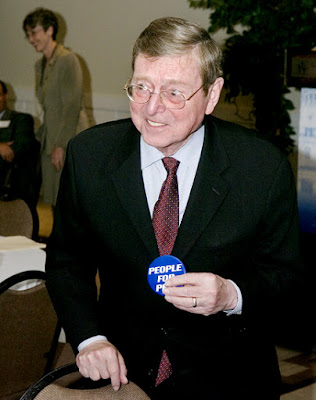
Domenici announced his retirement on Oct. 4, due to the uncertainties of being diagnosed with Frontotemporal Lobar Degeneration, an incurable disease that causes dysfunction of the brain.
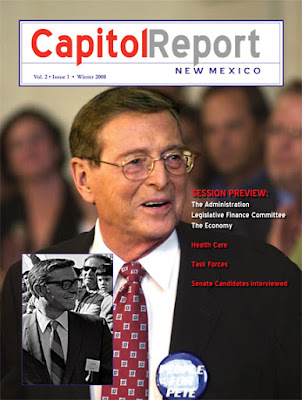 Capitol Report New Mexico will be distributed Jan. 9.
Capitol Report New Mexico will be distributed Jan. 9.Domenici was under a Senate Ethics Committee investigation for having called then U.S. Attorney David Iglesias about whether pending indictments of the Bernalillo County Metropolitan Courthouse investigation would be unsealed before the November 2006 election. The progress of the ethics investigation was suspended when he announced his retirement.
Domenici’s retirement at the end of 36 years opens the political floodgates. Three congressional seats were vacated by Representatives: Republicans Heather Wilson, District 1 and Steve Pearce, District 2 and Democrat Tom Udall, District 3 to run for Senate. Like a tsunami, it’s not just one wave but a series and backwash.
Even those who are politically attuned are having trouble keeping up with the names of and the number of people: considering runs for office, selecting races, announcing candidacies, dropping out of races, switching races and even switching districts.
2. On the first day of the year, Gov. Bill Richardson was sworn in, beginning his second four-year term in office. He announced his bid for the Democratic Party’s presidential nomination on ABC’s Jan. 21 Sunday morning news program, “This Week” with Chief Washington Correspondent George Stephanopoulos. Stephanopoulos was a former associate when both were in President Bill Clinton’s administration.
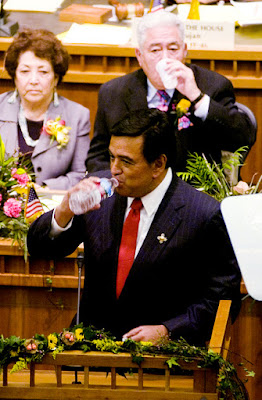 Richardson’s announcement came just a week after he opened the State Legislature’s 60-day session, declaring it the “Year of Water.”
Richardson’s announcement came just a week after he opened the State Legislature’s 60-day session, declaring it the “Year of Water.”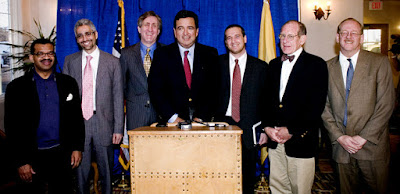 International concerns of genocide prompted Richardson to travel to the civil war-torn Dufar region of Sudan, where he helped obtain a 60-day cease-fire.
International concerns of genocide prompted Richardson to travel to the civil war-torn Dufar region of Sudan, where he helped obtain a 60-day cease-fire. He spent more time on the campaign trail than he has in the state tending to his office.
He spent more time on the campaign trail than he has in the state tending to his office.Richardson has lagged in the polls behind Democratic front-running Senators: Hillary Clinton of New York, Barack Obama of Illinois and former North Carolina Senator John Edwards.
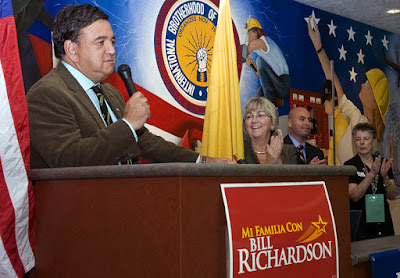 The state of Iowa holds its caucus on Jan. 3, followed by the New Hampshire primary, Jan. 8. Richardson feels he must move upwards in those two states’ selection processes in order to remain a viable candidate. Iowa and New Hampshire voters have a history of bucking poll leaders. The Iowa caucuses are not a straight one-man one-vote proposition, but a consensus affair. Sometimes, the second or third ranked candidate may emerge. This was true for Jimmy Carter and Bill Clinton, both governors. Richardson is hoping for similar results.
The state of Iowa holds its caucus on Jan. 3, followed by the New Hampshire primary, Jan. 8. Richardson feels he must move upwards in those two states’ selection processes in order to remain a viable candidate. Iowa and New Hampshire voters have a history of bucking poll leaders. The Iowa caucuses are not a straight one-man one-vote proposition, but a consensus affair. Sometimes, the second or third ranked candidate may emerge. This was true for Jimmy Carter and Bill Clinton, both governors. Richardson is hoping for similar results.3. Federal indictments were handed down against former State Senate Pro-Tem Manny Aragón, left, Contractor Raul Parra, center, former Metropolitan Court Administrator Toby Martinez and his wife Sandra Mata Martinez, right, alleging a kickback scheme of $4.2 million in construction of the new Bernalillo County Metropolitan Courthouse.
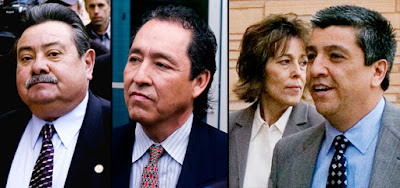 Former Albuquerque Mayor Ken Schultz, architect Marc Schiff and electronics subcontractor Manuel Guara, agreed to enter guilty pleas to two counts each of conspiracy and mail fraud, and to testify against the other four. In August, a related indictment was filed against Michael Murphy.
Former Albuquerque Mayor Ken Schultz, architect Marc Schiff and electronics subcontractor Manuel Guara, agreed to enter guilty pleas to two counts each of conspiracy and mail fraud, and to testify against the other four. In August, a related indictment was filed against Michael Murphy. 4. U.S. Attorney David Iglesias, right, along with seven other U.S. Attorneys were asked to resign on Dec.7, 2006, from their presidential appointed positions. They claim the firings were for illegal political reasons. Iglesias testified before two congressional hearings that Sen. Domenici and Rep. Wilson made improper phone calls during the 2006 election campaign.
4. U.S. Attorney David Iglesias, right, along with seven other U.S. Attorneys were asked to resign on Dec.7, 2006, from their presidential appointed positions. They claim the firings were for illegal political reasons. Iglesias testified before two congressional hearings that Sen. Domenici and Rep. Wilson made improper phone calls during the 2006 election campaign.Attorney General Alberto Gonzales, who denied to congress that there was any political component to the firings, came under increased pressure and resigned Aug. 27.
Prominent New Mexico Republicans complained about Iglesias to the Justice Department and White Hous , including: Attorney Patrick J. Rogers of the Modrall Sperling law firm; Albuquerque attorney, Mickey Barnett, who at one time was a Washington based Domenici aide, and later sat on the Republican National Committee representing New Mexico, and currently is a presidential appointed Postal Service Governor; and current Bernalillo County Sheriff Darren White and Republican candidate for N.M. Congressional District 1, who has been involved the State Republican Party, serving as chairman for President Bush's 2004 re-election campaign in Bernalillo County.
White House Deputy Chief of Staff Karl Rove, who was also in charge of: the Office of Political Affairs, the Office of Public Liaison, and the White House Office of Strategic Initiatives, was suspected of orchestrating the politics of the firings. He resigned, leaving the White House Aug. 31.
5. Albuquerque’s Mayor Martin Chávez had multiple failures:
In July, Chávez traveled to China and while there, attempted to secure a Panda for the Rio Grande Zoo.
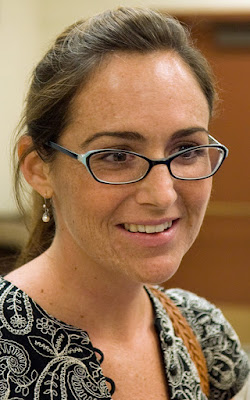 Chávez openly supported political newcomer Kathryn Martinez, left, to run against Council President Debbie O’Malley. Though he denied publicly supporting another candidate, Paulette de Pascal, in the City Council District 4 race held by Brad Winter, several of Chávez’ mayoral staff members were involved in her campaign. A five Councillor majority coalition had formed blocking several of Chávez’ initiatives. Martinez was soundly defeated and de Pascal lost by the largest margin in the city’s current form of elections.
Chávez openly supported political newcomer Kathryn Martinez, left, to run against Council President Debbie O’Malley. Though he denied publicly supporting another candidate, Paulette de Pascal, in the City Council District 4 race held by Brad Winter, several of Chávez’ mayoral staff members were involved in her campaign. A five Councillor majority coalition had formed blocking several of Chávez’ initiatives. Martinez was soundly defeated and de Pascal lost by the largest margin in the city’s current form of elections.Chávez vetoed a proposed charter amendment that would make recalling elected city officials nearly impossible. The Council overrode the veto and the electorate passed the amendment.
Voters approved an amendment that took away the sole prerogative of the mayor to make all appointments to city boards and commissions. The Council can now make some appointments where authorized by ordinance.
Chávez solicited contributions for “Chávez for New Mexico” without announcing any solid intentions to run for a particular office.
 Chávez expressed an interest in the office of governor, especially after Lt. Gov. Diane Denish, above, was reelected and announced that she was putting her residual funds from last year’s election into a run for governor in 2010. Statewide polling numbers showed Denish would soundly defeat Chávez in a primary. So, he quietly went away.
Chávez expressed an interest in the office of governor, especially after Lt. Gov. Diane Denish, above, was reelected and announced that she was putting her residual funds from last year’s election into a run for governor in 2010. Statewide polling numbers showed Denish would soundly defeat Chávez in a primary. So, he quietly went away. Chávez said that he was also interested in being a Senator, but would not run against Domenici, offering his support for him instead. When Domenici retired, Chávez announced for the office. Then, when Rep. Udall, above, entered the race, statewide polling numbers showed Udall would soundly defeat Chávez in a primary, especially in Hispanic areas that Chávez thought would support him. He again withdrew quietly.
Chávez said that he was also interested in being a Senator, but would not run against Domenici, offering his support for him instead. When Domenici retired, Chávez announced for the office. Then, when Rep. Udall, above, entered the race, statewide polling numbers showed Udall would soundly defeat Chávez in a primary, especially in Hispanic areas that Chávez thought would support him. He again withdrew quietly. Chávez threatened the University of New Mexico at a protest rally before a public meeting over a proposed development on the North Campus Golf Course by suggesting he would not approve required construction permits.
Chávez threatened the University of New Mexico at a protest rally before a public meeting over a proposed development on the North Campus Golf Course by suggesting he would not approve required construction permits.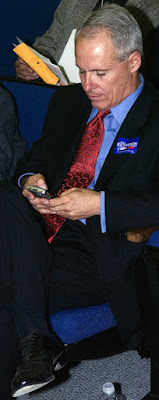 Chávez added to the list of offenders who he feels compelled to publicly vilify. His weapon of choice after conviction and sentence is to use a high tech form of the scarlet letter, newspaper advertising, showing the jailhouse mugshots of selected offenders. He has previously gone after sex offenders, drunk drivers and this year, street gangsters.
Chávez added to the list of offenders who he feels compelled to publicly vilify. His weapon of choice after conviction and sentence is to use a high tech form of the scarlet letter, newspaper advertising, showing the jailhouse mugshots of selected offenders. He has previously gone after sex offenders, drunk drivers and this year, street gangsters.Chávez’ penchant for the Red Light/Speed cameras caused him no end of political problems. Legislators made moves on forcing the abandonment of the program or having fines go through the state that would take a portion of the proceeds. Eventually, legislation required the city to provide a method of warning for drivers approaching camera-monitored intersections, including the use of flashing lights or rumble strips. After publicly complaining about the state imposed action, the city cut rumble strips into the roadways, rather than installing more expensive flashing warning lights.
The Governor vetoed another bill that had passed by huge margins in both houses of the state legislature. It would have required that fines collected by the city’s “civil” process and administrative hearing officer’s procedures, go through the courts fee system to help pay down the bonds for the Metropolitan Court building. Sen. Timothy Z. Jennings, D - Chaves, Eddy, Lincoln and Otero counties, complained that by allowing Albuquerque to retain the proceeds of the Safe Traffic Operations Program, also known as the STOP ordinance, the rest of the state was having to unfairly fund a greater portion of the Metropolitan Court.
Chávez defended the extra millions of dollars the program generated, but refused to call them profits.
The City Council had been assured each time the City’s STOP ordinance, was reviewed, that it was self funded and any excess would be used to maintain and expand the program and to fund support of prosecutors in the District Attorneys office, especially for methamphetamine enforcement. A one-time contribution was made and now the “excess funds” were used to balance the budget rather than for the maintenance of the ordinance.
Chávez, feeling political pressure, appointed a task force, including members of the federal government to review the issue of automated enforcement. Observers doubt that there will be any serious look at the underlying issues and believe the task force will rubber stamp the mayor’s support.
The City Council voted to suspend the STOP ordinance until the task force renders its report due Jan. 15. Chávez vetoed the suspension and the council overrode the veto.
 Just a couple of thoughts on the other stories on AP’s list.
Just a couple of thoughts on the other stories on AP’s list. State Senator James Taylor, above, District 14, D, Bernalillo and Valencia Counties, grabbed a smoke after the opening session. The Capitol building was previously designated as a no smoking facility in a bill named after it’s strong supporter, former First Lady Dee Johnson. The legislature outlawed smoking in all public buildings.
State Senator James Taylor, above, District 14, D, Bernalillo and Valencia Counties, grabbed a smoke after the opening session. The Capitol building was previously designated as a no smoking facility in a bill named after it’s strong supporter, former First Lady Dee Johnson. The legislature outlawed smoking in all public buildings.During the same session, Medical Marijuana legislation was passed. There seems to be a disconnect; smoking one kind of plant is deemed hazardous to someone else’s health while the smoking of another kind of plant is deemed to be of medicinal value. I know all the arguments; it just doesn’t make sense when the two issues appear in the same paragraph.
 As for the Statewide Cockfighting ban; most New Mexico counties and cities and many towns had already outlawed the blood sport.
As for the Statewide Cockfighting ban; most New Mexico counties and cities and many towns had already outlawed the blood sport.The strongest argument for not banning the grisly venture was a reliance on provisions of the Treaty of Guadalupe Hidalgo having to do with respect for religion and culture.
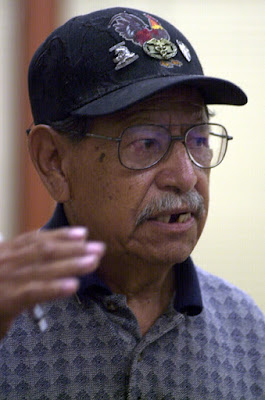 At a North Valley City Council candidate forum, sponsored by New Mexico Vecinos Unidos, Carlos Cansino, wearing his cockfighting cap, called for the City Council to reinstate cockfighting in Albuquerque using the Treaty of Guadalupe Hidalgo.
At a North Valley City Council candidate forum, sponsored by New Mexico Vecinos Unidos, Carlos Cansino, wearing his cockfighting cap, called for the City Council to reinstate cockfighting in Albuquerque using the Treaty of Guadalupe Hidalgo.ARTICLE IXThe Mexicans who, in the territories aforesaid, shall not preserve the character of citizens of the Mexican Republic, conformably with what is stipulated in the preceding article, shall be incorporated into the Union of the United States. and be admitted at the proper time (to be judged of by the Congress of the United States) to the enjoyment of all the rights of citizens of the United States, according to the principles of the Constitution; and in the mean time, shall be maintained and protected in the free enjoyment of their liberty and property, and secured in the free exercise of their religion without; restriction.
The 1848 treaty applied to all the land that changed hands after the Mexican-American war. The area became U.S. territories that are now the states of California, Nevada, Utah, and parts of Arizona, Colorado, Wyoming and New Mexico. All of them have successfully banned cockfighting. The State’s ban has withstood its first challenge when a state District Court refused to issue an injunction to ban enforcement of the law earlier this month.
It further would seem that only those parts of New Mexico, west of the Rio Grande, were covered by the treaty, because when Texas gained its independence from Mexico in 1836, the western border was the river.
It seems to me that in 1848, people had the right to smoke in public buildings; they even had the right to smoke marijuana in public buildings. However, as a society we have seen fit to curtail those rights and what was “maintained and protected in the free enjoyment of their liberty and property,” is no longer. Killing chickens with razorblades attached to their legs, as sport, just isn’t acceptable social behavior anymore.
So, the year 2007 is in the bag.
2008 looks promising, Happy New Year!
No comments:
Post a Comment